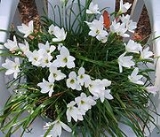
Zephyranthes candida
Encyclopedia
Zephyranthes candida, known as the Fairy Lily or White Rain Lily, is a native to the Rio de la Plata
region of South America
including Argentina
and Uruguay
but also native to Paraguay
and Chile
.
Other names: August rain lily, White zephyr lily, Peruvian swamp-lily, Zephyr flower, and Autumn zephyr lily.
This is a white cultivar
of a flower usually found in pink flowering forms, Candida, grows 152 mm to 254 mm (6-10 inches) tall. It's ideal for rock gardens and for tucking into groundcovers.
Leaves are a deep glossy green and measure 3 mm
wide. Flowers are erect in perianth white or sometimes pinkish abaxially. The leaf-like bract
is 1.8 to 4 cm. They grow best in full sun to part shade and require a medium wet soil.
Propagation is done by dividing bulb
s or offsets and from seed.
Zephyranthes candida was first described by John Lindley
in 1823 as Amaryllis candida. It was renamed under its current name in 1826 by William Herbert.
Río de la Plata
The Río de la Plata —sometimes rendered River Plate in British English and the Commonwealth, and occasionally rendered [La] Plata River in other English-speaking countries—is the river and estuary formed by the confluence of the Uruguay River and the Paraná River on the border between Argentina and...
region of South America
South America
South America is a continent situated in the Western Hemisphere, mostly in the Southern Hemisphere, with a relatively small portion in the Northern Hemisphere. The continent is also considered a subcontinent of the Americas. It is bordered on the west by the Pacific Ocean and on the north and east...
including Argentina
Argentina
Argentina , officially the Argentine Republic , is the second largest country in South America by land area, after Brazil. It is constituted as a federation of 23 provinces and an autonomous city, Buenos Aires...
and Uruguay
Uruguay
Uruguay ,officially the Oriental Republic of Uruguay,sometimes the Eastern Republic of Uruguay; ) is a country in the southeastern part of South America. It is home to some 3.5 million people, of whom 1.8 million live in the capital Montevideo and its metropolitan area...
but also native to Paraguay
Paraguay
Paraguay , officially the Republic of Paraguay , is a landlocked country in South America. It is bordered by Argentina to the south and southwest, Brazil to the east and northeast, and Bolivia to the northwest. Paraguay lies on both banks of the Paraguay River, which runs through the center of the...
and Chile
Chile
Chile ,officially the Republic of Chile , is a country in South America occupying a long, narrow coastal strip between the Andes mountains to the east and the Pacific Ocean to the west. It borders Peru to the north, Bolivia to the northeast, Argentina to the east, and the Drake Passage in the far...
.
Other names: August rain lily, White zephyr lily, Peruvian swamp-lily, Zephyr flower, and Autumn zephyr lily.
This is a white cultivar
Cultivar
A cultivar'Cultivar has two meanings as explained under Formal definition. When used in reference to a taxon, the word does not apply to an individual plant but to all those plants sharing the unique characteristics that define the cultivar. is a plant or group of plants selected for desirable...
of a flower usually found in pink flowering forms, Candida, grows 152 mm to 254 mm (6-10 inches) tall. It's ideal for rock gardens and for tucking into groundcovers.
Leaves are a deep glossy green and measure 3 mm
Millimetre
The millimetre is a unit of length in the metric system, equal to one thousandth of a metre, which is the SI base unit of length....
wide. Flowers are erect in perianth white or sometimes pinkish abaxially. The leaf-like bract
Bract
In botany, a bract is a modified or specialized leaf, especially one associated with a reproductive structure such as a flower, inflorescence axis, or cone scale. Bracts are often different from foliage leaves. They may be smaller, larger, or of a different color, shape, or texture...
is 1.8 to 4 cm. They grow best in full sun to part shade and require a medium wet soil.
Propagation is done by dividing bulb
Bulb
A bulb is a short stem with fleshy leaves or leaf bases. The leaves often function as food storage organs during dormancy.A bulb's leaf bases, known as scales, generally do not support leaves, but contain food reserves to enable the plant to survive adverse conditions. At the center of the bulb is...
s or offsets and from seed.
Zephyranthes candida was first described by John Lindley
John Lindley
John Lindley FRS was an English botanist, gardener and orchidologist.-Early years:Born in Catton, near Norwich, England, John Lindley was one of four children of George and Mary Lindley. George Lindley was a nurseryman and pomologist and ran a commercial nursery garden...
in 1823 as Amaryllis candida. It was renamed under its current name in 1826 by William Herbert.

